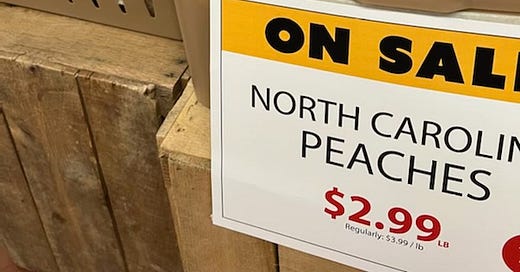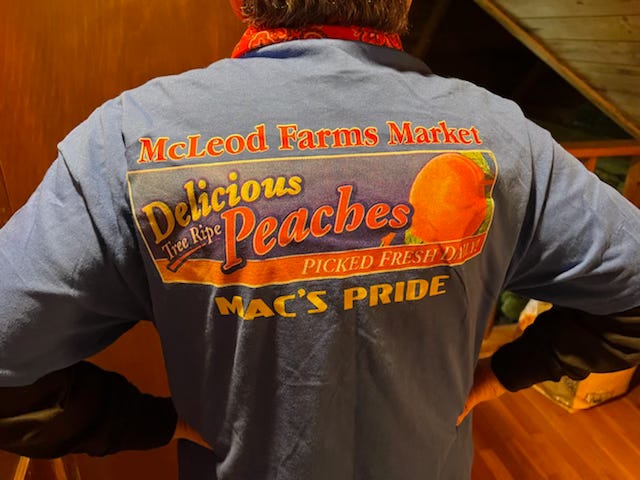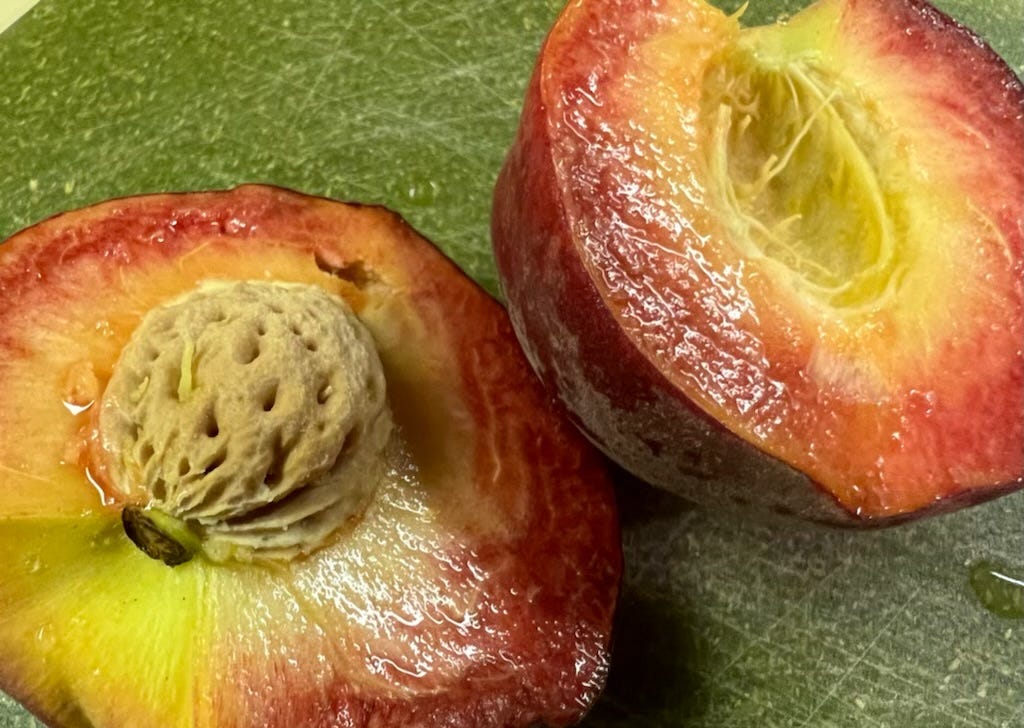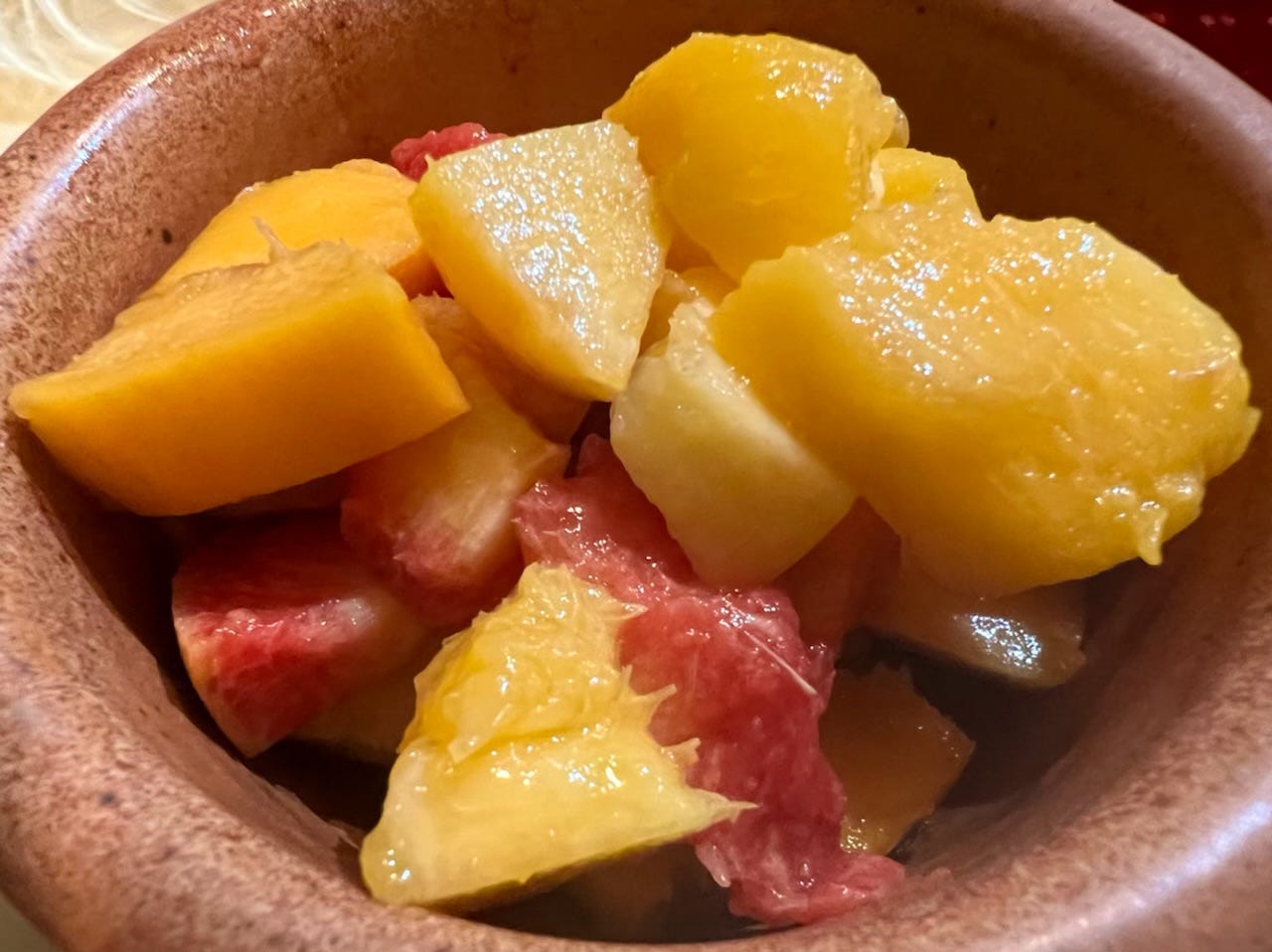On Sunday afternoons in June, after church and the big meal of the day, my grandmother’s children and grandchildren would come by for a visit with her. The talk on the screened porch, scented by blooming gardenias alongside the house, would sooner or later turn to peaches. This was Georgia in the 1960s. My grandfather had been an orchard hand as a young man and planted fruit trees first thing when he finally managed to buy five acres in the 1940s. He knew his peaches, and therefore so did his children.
The family favorites were Elberta, a freestone peach with yellow flesh, and Georgia Belle, a large, crimson freestone with pale flesh. According to Stark Brothers—the old timey fruit tree catalog he swore by—both of these peach varieties were developed in the 1870s in Georgia. “Freestone” means the pit is easier to remove than in “clingstone” peaches. My grandmother would tell you that a freestone was much better for canning, since the pits had to be removed by hand. I still associate cling peaches with the icky sweet and slimy peaches that came out of metal cans and held a scoop of cottage cheese at “ladies lunches.”
Peaches were something we anticipated and worried about in my family; namely, whether the trees would get the right number of chill spring nights without a hard freeze. Planting them on higher ground—since cold air tends to sink downslope—is preferable. Sandy, loamy soil that drains well is also a requirement. Summer rain, not drought, helps with sweetness.
Talking about the weather on summer Sundays, therefore, was more than small talk among my people. It was about anticipation of the tastes to come—pies, hand-cranked ice cream, and pickled peaches—if the temperatures cooperated. Even after my grandfather died, the peach season speculations continued. Sadly, my grandmother and her sons soon realized they could not handle the meticulous pruning and spraying of granddaddy’s peach and plum trees. They cut them down, though my grandmother would continue to push-mow the lawn, grow tomatoes, and weed her enormous flower beds—now with less shade from the orchard—until her late 80s. And everyone kept talking about where they’d source their peaches—which produce stand or market, how far they’d have to go—to find some good ones.
These memories rose up as we were traveling though Alabama recently. It was well before Memorial Day, and I couldn’t believe that the first fruit stand we passed south of Birmingham en route to Montgomery had peaches for sale. I did not realize we were in Chilton County, the home of the earliest and by most accounts, the best peaches in Alabama. The county even has a peach-shaped water tower in the county seat of Clanton. It looks very much like the more famous one on I-85 in Gaffney, South Carolina. Though peaches are the leading fruit crop in Alabama, the state ranks 18th among U.S. peach producers.
Being from Georgia, I thought I knew peaches, but apparently, I do not.
Peaches (Prunus persica) are native to China where they still reportedly grow in the wild. According to one bioscience journal, “Peach pits have been found at Neolithic sites in China dating back to 7000 BCE, where peach domestication began at least 4000 years ago.” The tree eventually made its way to India, Persia, Greece, and then to the Mediterranean. Jesuit monks brought the fruit to St. Augustine in Florida and Georgia’s St. Simons and Cumberland islands in the 16th century. The Cherokee people who had contact with Spanish explorers were growing peaches by the 18th century.
Following Emancipation on Juneteenth 1865, Georgia began searching for a more favorable identity and an economy not based on cotton, and peach production took off. Peaches must be picked by hand, however, and the job of peach picking during Jim Crow was largely shouldered by poorly paid African Americans, and now by migrant farmworkers. Georgia’s public relations mavens worked hard to live into the state’s official branding as “The Peach State.” However, according to the University of Georgia’s 2014 Georgia Farm Gate Value Report and for some time now, “the state makes more money from pine straw, blueberries, deer hunting leases, and cabbages.”
Three quarters of the peaches grown in the U.S. today come from California, which means they are picked before ripening and shipped great distances. South Carolina runs a not-so-close second, and Georgia now comes in third with a crop about a third the size of South Carolina’s. As might be expected, Georgia promotes its peaches as the most delicious, but my friend Beth, who hosted us in Montgomery, Alabama, swears the best peaches come from McBee, South Carolina, near her former home. Beth grudgingly admitted that the peaches we picked up that day in Chilton County, however, came very close to the sweetness of South Carolina’s finest.
I have been to McBee more than once, and this time of year, McLeod Farms, just off Highway 1, which bisects South Carolina, is jammed with peach lovers. McLeod’s main marketplace is choc-a-bloc with candies, ice cream, baked goods, knick knacks, and fresh produce. The McLeod family grows 30 varieties of peaches that ripen between mid-June to mid-August—all grown in the surrounding South Carolina Sandhills. About half, the first to ripen, are clingstones. The other half, which ripen in July and August, are freestones. Founded in 1916, McLeod’s began with Georgia Belles and Elberta peaches, both Georgia varieties. With their peaches ripening two weeks in advance of North Carolina’s crop, they have marketed heavily in the Carolinas. With the ready assistance of UPS, they now ship peaches across the country in fancy gift boxes.
McBee is now the beating heart of South Carolina peach country, but I still remember when Interstate 85 to the west was flanked on both sides by rolling hills, blanketed with spreading peach trees precisely pruned to the same height and laid out in a perfect grid. In spring the gray limbs reaching upward were topped with delicate pink blossoms, something like rows of tutu-clad ballerinas standing on their heads. In summer, hand painted signs and billboards competed between exits from Spartanburg to Greenville, tempting drivers to pull off for a taste of their dripping sweetness. Today those peach trees have been replaced by boxy white buildings that stretch for acres. Inside, cars and other automotive components are manufactured by international corporations.
As my grandfather knew, peach growing is a difficult practice, now made more challenging by changing weather. Peach trees thrive from about 12 to 20 years. They are also subject to a harrowing pathogenic bacterium that all but ruined Georgia’s crop back in 1929 and has struck every few decades since. Called Phony Peach Disease or PPD, this infection does not show up until the fruit appears. Otherwise, the foliage seems robust and dense.
And what about peaches from North Carolina? Most are grown in what North Carolinians also call the Sandhills—about an hour north of McBee in an area just east of the ancient Uwharrie Mountains and west of the golf Mecca of Pinehurst. North Carolina’s peach industry ranks 7th in the nation. According to Montgomery County Extension Agent Paige Burns Clark, “After World War I, many wealthy Northerners came down to the Sandhills as part of a ‘back to the land’ movement in reaction to Industrialization in the North, and were instrumental in starting the peach industry in the region. At the peak of peach production in the Sandhills around 1920, there were 300,000 acres of peaches; now, there are just around 3,000 in the entire state.”
Farmers in and around the towns of Ellerbee, Candor, and Windblow are growing some of the same varieties as in other southern states, but most don’t open their stands until July 1, because of their later ripening. But here’s the North Carolina advantage, according to Paige Burns Clark: “In North Carolina, peaches are tree ripened and packed in the orchard. This means NC peaches are more delicious than any other. Peach growers in other states often grade peaches and pack for shipping. The peach is picked “mature” – less than ripe – so it can withstand the rigors of bouncing down a pack line, graded, packed, and stored before being shipped out. North Carolina growers got out of the shipper market decades ago, and you can taste the difference.”
And so, the competitive promotion of peaches goes on. I have tried for several years to make it to Windblow in time to taste their namesake peach, a freestone that was developed at the Sandhills Research Station, a facility operated by North Carolina State University, one mile north of the crossroads of Highway 73 and State Road 1003. Windblow is the unincorporated community at that crossroads. It comes by its name honestly. The land sits high on the Sandhills landscape on the border of Montgomery and Richmond counties. The main purveyor of Windblow peaches is Bynum Peach Farm, just south of the crossroads on Highway 73. Call them right now and you’ll get a recorded message saying that they will open July 1. Get there in early July or the Windblows will likely be gone.
In preparation for this ephemeral event, I did some advance taste testing of several NC peaches, including a very ripe variety from Candor (found at a modest stand in Hillsborough); two varieties from the Greensboro Farmer’s Market—Flavor Rich and Ruby Prince; and a CaroRed found at Weaver Street Market in Carrboro. (The Weaver Street peaches came from Pee Dee Farms in Lilesville, which is in Anson County, a bit farther south and west than the other peaches.)
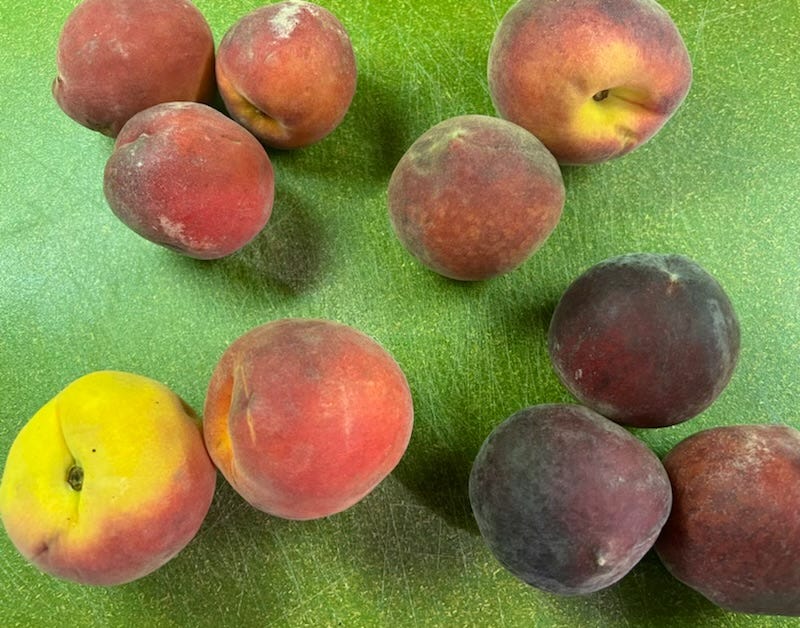
After a thorough washing, Donna cut each peach in half to photograph them. Ironically, the peach named Flavor Rich was the least of these. Perhaps the name was meant to compensate, or maybe it was not as ripe as the others. All were clingstones, given how early we are in the season, but the stones easily came free. Their ripeness gave credence to the theory that NC peaches are allowed to ripen longer on the tree before going to markets close by.
Far and away the Ruby Prince was the most intriguing to me—luscious, juicy and sweet. The interior of this peach is partially red as if dyed from the outside in. It stained the tea towel we used to dry it off! The other two peaches from Candor and from Lilesville tied for their perfume, inseparable in both taste and aroma. Donna preferred these because of their traditional peach flavor along with the tinge of a tart aftertaste. Not a hair’s breadth difference in delicious. We hit the peach jackpot in North Carolina.
So in the end, ripeness is key. Biting into several slices, I noted across all the peaches how the sweetness grows from the outside in.That is, the flesh closest to the skin of the peach is the sweetest, just the opposite of what we discovered with cantaloupes a few years ago while sampling North Carolina’s finest homegrown melons for my book, The Month of Their Ripening: North Carolina Heritage Foods through the Year. It makes sense, since the sun is the secret to ripening. Looks like a good year for peaches, and scarcity makes them all the sweeter in North Carolina.


